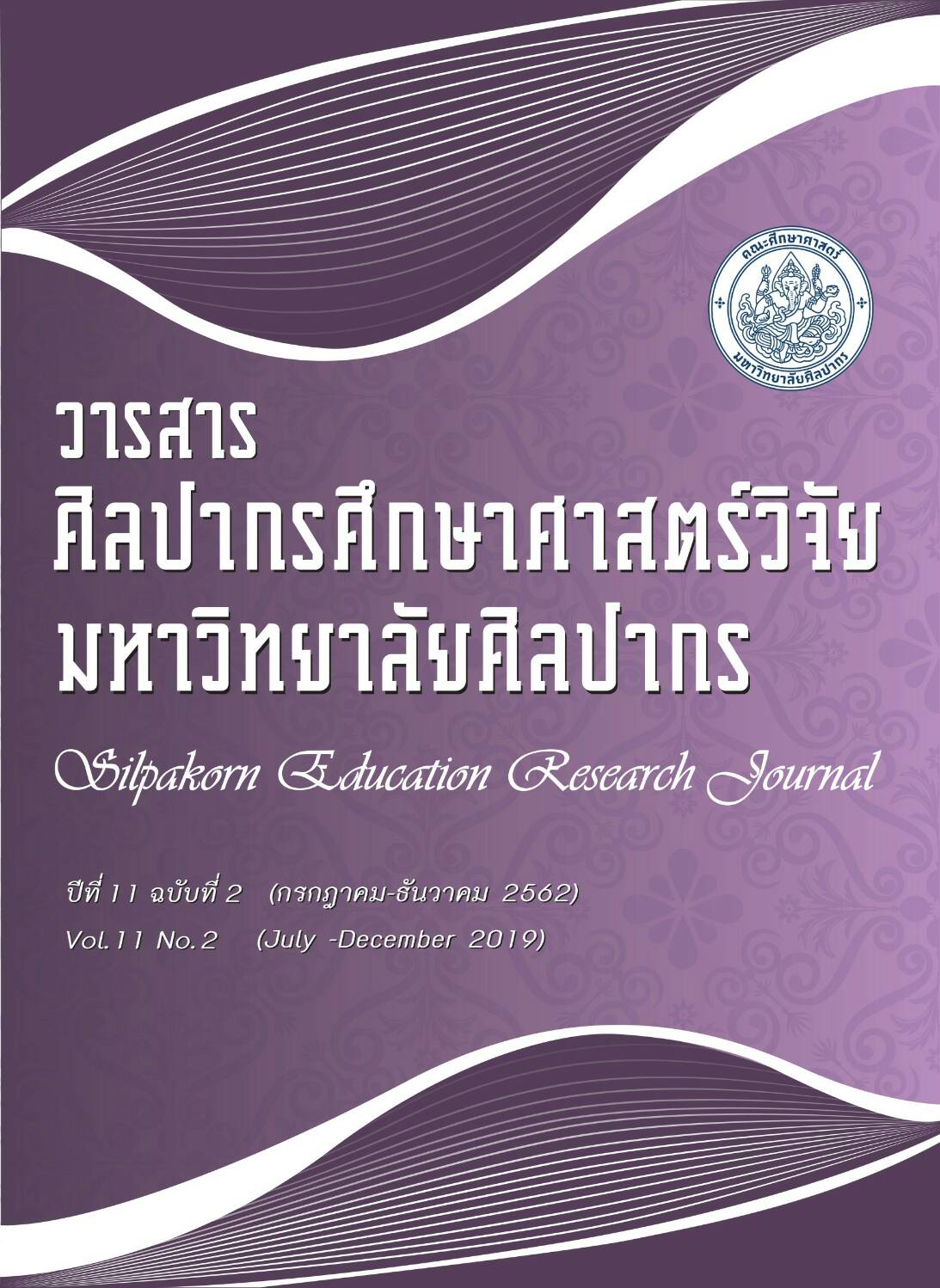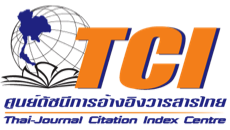การพัฒนากระบวนทัศน์การสอนและการเรียนรู้เพื่อส่งเสริม ทักษะการคิดขั้นสูง ในยุคการศึกษา 4.0 ของนักศึกษาวิชาชีพครู (The Development of a Teaching and Learning Paradigm That Promotes Higher-Order Thinking Skills in the Age of Education 4.0 Among Education Students)
คำสำคัญ:
กระบวนทัศน์การเรียนรู้, ทักษะการคิดขั้นสูง ในยุคการศึกษา 4.0, Learning Paradigm, Higher-order Thinking Skills in the Age of Education 4.0บทคัดย่อ
บทคัดย่อ
วัตถุประสงค์ของวิจัยเพื่อ 1) พัฒนากระบวนทัศน์การเรียนรู้เพื่อส่งเสริมทักษะการคิดขั้นสูงในยุคการศึกษา 4.0 2) เปรียบเทียบผลการเรียนรู้ วิชาการพัฒนาหลักสูตรก่อนและหลังการจัดการเรียนรู้ตามกระบวนทัศน์การเรียนรู้เพื่อส่งเสริมทักษะการคิดขั้นสูง ในยุคการศึกษา 4.0 3) ศึกษาความสามารถในการพัฒนาหลักสูตร และ4) สอบถามความคิดเห็นของนักศึกษาที่มีต่อการจัดการเรียนรู้ตามกระบวนทัศน์การเรียนรู้ กลุ่มตัวอย่าง ได้แก่ นักศึกษาปริญญาตรี สาขาวิชาการศึกษาปฐมวัย คณะครุศาสตร์ มหาวิทยาลัยนครพนม ปีการศึกษา 2561 จำนวน 28 คนได้มาโดยการสุ่มแบบกลุ่ม เครื่องมือวิจัยได้แก่ แบบทดสอบความรู้ แบบสอบถาม วิเคราะห์ข้อมูลโดยการวิเคราะห์ค่าความถี่ ค่าร้อยละ และการทดสอบค่าที ผลการวิจัย พบว่า
- 1. กระบวนทัศน์การเรียนรู้เพื่อส่งเสริมทักษะการคิดขั้นสูงในยุคการศึกษา 0 มี 3 ขั้นตอน ดังนี้ 1) การวิเคราะห์ความต้องการในการการเรียนรู้ ได้แก่ การกำหนดจุดมุ่งหมายการเรียนรู้ และการกำหนดระดับคุณภาพของการเรียนรู้ในรูปแบบของภาระงาน 2) การปฏิบัติการเรียนรู้ ได้แก่ คือ การออกแบบการเรียนรู้หรือเลือกกลยุทธ์ในการเรียนรู้ การพัฒนาทักษะการเรียนรู้แบบนำตนเอง และการบูรณาการความรู้อาศัยความร่วมมือกัน 3) การประเมินการเรียนรู้ ได้แก่ คือ การตรวจสอบแบบย้อนคิดทบทวน และการประเมินความรู้เปรียบเทียบกับมาตรฐาน กระบวนทัศน์การเรียนรู้ที่พัฒนาขึ้น มีประสิทธิภาพตามเกณฑ์ 80/80 ได้ค่าประสิทธิภาพ E1/ E2 = 80.95 / 81.36 และมีค่าดัชนีประสิทธิผล (Effectiveness Index ;E.I ) ตามเกณฑ์สูงกว่า 0.5 ได้ค่า E.I = 0.63
- การเปรียบเทียบผลการเรียนรู้ วิชาการพัฒนาหลักสูตร พบว่าคะแนนเฉลี่ยหลังเรียนสูงกว่าคะแนนเฉลี่ยก่อนเรียนอย่างมีนัยสำคัญทางสถิติที่ระดับ.01
- นักศึกษามีความสามารถในการพัฒนาหลักสูตร อยู่ในระดับดี
- นักศึกษามีความคิดเห็นต่อการจัดการเรียนรู้ เห็นด้วยอยู่ในระดับมากทุกข้
เอกสารอ้างอิง
Anderson, L. W. and Krathwohl, D. R., et al (Eds.). (2001). A Taxonomy for Learning,
Teaching, and Assessing: A Revision of Bloom’s Taxonomy of Educational Objectives.
Allyn & Bacon. Boston, MA (Pearson Education Group).
Bel E. and Mallet M. (2006). Constructionist Teaching in The Digital Age- A Case Study. IADIS International Conference on Cognition and Exploratory Learning in Digital Age (CELDA 2006) :371-375.
Bellnca J., Brandt R. (2010) 21st century skills : rethinking how students learn. Bloomington, IN :Solution Tree Press.
Bloom, B., Englehart, M.D., Furst, E.J., Hill, W.H., &Krathwohl, D.R. (1956).“Taxonomy of educational objectives”. : Handbook I , cognitive domain. New York : David Mckay
Education reform to make officials accountable Jun 03. 2018 https://www.nationthailand.com/national/30346892
Edward L. Pizzini, Daniel P. Shepardson and Sandra K. Abell. (1989). “A Rationale for and the Development of a Problem Solving Model of Instruction in Science Education”. Science Education 73(5) :523-534
Harkins, A.M. (2008). “ Leapfrog Principles and Practices”. Core Components of Education 3.0 and 4.0. Future Research Quarterl. 24(1) : 19-32
Hovland, Lumsdaine and Sheffield. (1949). Cited in Goodman, R.I.,Fletcher, K.A. and Schneider, E.W. 1980. The effectiveness Index as a comparative measure in media product evaluation. Educational Technology. 20(09): 30-34.
Johnson, David W., Johnson Roger T., and Johnson Edythe, H. (1994). The New Circles of Learning Cooperation in the Classroom and School. Alexandria Virginia : ASCD.
Joyce, B, & Weil, M. (1996). Model of Teaching. 5th ed. Boston : Allyn and Bacon.
Joyce, B. & Weil, M. (2000). Models of Teaching. 6th ed. Boston: Allyn and Bacon
International Commission on Education for the Twenty-first Century. (online) Learning : the
treasure within; https://unesdoc.unesco.org/ark:/48223/pf0000109590.
Independent Committee for Education Reform (ICER) online Digital Platform Retrieved May 3.
2018 from https://www.moe.go.th/moe/th/news/detail.php?NewsID=51205&Key=news2
(in Thai).
Murphy, E. (1997). Characteristics of constructivist teaching and learning. constructivism: From philosophy to practice. Intelligence Organizes the World by Organizing Itself.
Osborne And Wittrock. (1983 ). “Osborne, R. and Wittrock, M. (1983). Learning Science: A Generative Process”. Science Education.67(4) : 489-508.
Ruangrit, N. (2018). “ The research and development of instructional design model for
Massive Open Online Course in Higher Education for Educational Courses”. Veridian
E - Journal, Silpakorn University (Humanities, Social Sciences and arts 11(4) : 950 –
961 (in Thai)
Runcharoen, T. (2017) Direction of Educational toward Education 4.0 in the Digital Age. Nakornratchsima :Nakornratchsima College (in Thai)
Songserm, U. (2012). The Development of Learning Outcome in Local Curriculum of Third Grade Students in Curriculum Development Subject Taught by Using Cooperative Learning in Team Game Tournament Technique. Faculty of Education, Silpakorn University (in Thai)
Khemmani, T. (2008). Teaching Strategies: Knowledge for Effective. Learning Process. 8th edition. Bangkok: Chulalongkorn University. Publishing. (in Thai)
Uamcharoen, S. Lowriendee, W. and Mongkol, P. (2016). “The Development of Constructivist Learning Model for the Student Teachers”. Silpakorn Educational Research Journal, 8(1) : 28-46 (in Thai)
Wright, S. Paul, Horn, Sandra P. and Sanders, William L. (1997). “Teacher and Classroom
Context Effects on Student Achievement : Implications for Teacher Evaluation”.
Journal of Personnel Evaluation in Education 11(1): 57-67.





